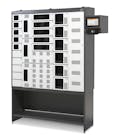Report: Shrink cost retailers more than $112B globally in 2012
According to the findings of a new study released today, losses from shrink, which include shoplifting, employee fraud, organized retail crime (ORC), and administrative errors, cost retailers more than $112 billion last year, representing 1.4 percent of retail sales on average. The 2012-2013 Global Retail Theft Barometer, which was conducted by Euromonitor International and underwritten by an independent grant from loss prevention solutions provider Checkpoint Systems, is based on interviews and surveys of 157 companies in 16 countries. These companies generated more than $1.5 trillion in sales last year.
Among the countries researched, Japan (1 percent of retail sales), Australia (1.1), Hong Kong (1.1 percent), and Germany (1.1 percent) had the lowest rates of shrink, while Brazil (1.6 percent), Mexico (1.6 percent) and Argentina (1.5 percent) were among the highest recorded. The U.S. was also near the top of the list, as the study found that shrink rates across the nation accounted for 1.5 percent of retail sales. Every country included in the study with the exception of the UK (stable), Germany (declining) and Hong Kong (stable) saw an increase in shrink in 2012.
“Retailers continue to fight; they do everything right, they have the right products, they have the right quantities at the right time on the store shelf and then they get hurt with products being stolen and then they lose sales to good customers. It’s all about on-shelf availability for them now,” said Dan Reynolds, vice president at Checkpoint Systems. “Some of the key findings were that the necessities are not being stolen by dishonest customers. It’s really the high-desirability, high-value items that are being taken and I think that’s a result of the U.S. economy kind of still lagging and unemployment still being high and they’re trying to make ends meet on a smaller budget.”
Shoplifting made up the majority of losses due to shrink in every country studied, while employee theft accounted for the second highest percentage of losses. In the U.S., however, losses from shoplifting (34 percent) and employee theft (32 percent) were nearly the same.
Earlier this year, the 25th Annual Retail Theft Survey released by Jack L. Hayes International found internal employee theft to be a growing problem for retailers across the U.S. According to the survey, 71,095 dishonest employees were apprehended in 2012, which was up 5.5 percent from 2011. Retailers recovered over $50 million from these employees, which was also more than in 2011. The data shows that one out of every 40 employees stole from their retail employer in 2012, and on average, dishonest employees steal approximately 5.5 times the amount of retail goods than true shoplifters.
“You have a lot of turnover at some of the retailers. We found that when you don’t have that turnover and you have a good manager in the store, the shrink falls,” Reynolds explained. “But, when you have higher turnover, it is harder to instill the disciplines and focus on store shrink.”
According to the Global Retail Theft Barometer, however, shares of shrink loss can vary depending on a number of different factors including retailer type, size and company management of loss prevention. For example, the study found that shoplifting rates are generally lower in grocery stores, which tend to be more prone to supplier fraud and administrative losses. In addition, the study said that ORC can be a factor in cases of both employee theft and shoplifting. The most commonly stolen items, according to the study, are those that are small, easy to conceal and have a high value such as branded clothing and electronics.
“One of the main takeaways (from the study) and it’s something a lot of our retailers do already is to have an overall loss prevention program,” Reynolds said. “One of the things that we hear a lot from our customers is that our solutions – EAS (electronic article surveillance) – is their first line of defense and is also their backbone for their overall program. Each corner is a different challenge, a different item and it gives them more of a laser focus than a shotgun approach to go after those different challenges that come up. The ones that implement that feel they have a lower shrink (rate) than the 1.5 percent average. It has to be a philosophy all the way from the C-suite of the retailer down to the individual stores.”
Click here for more information or to find out how you can receive a free electronic copy of the report.



